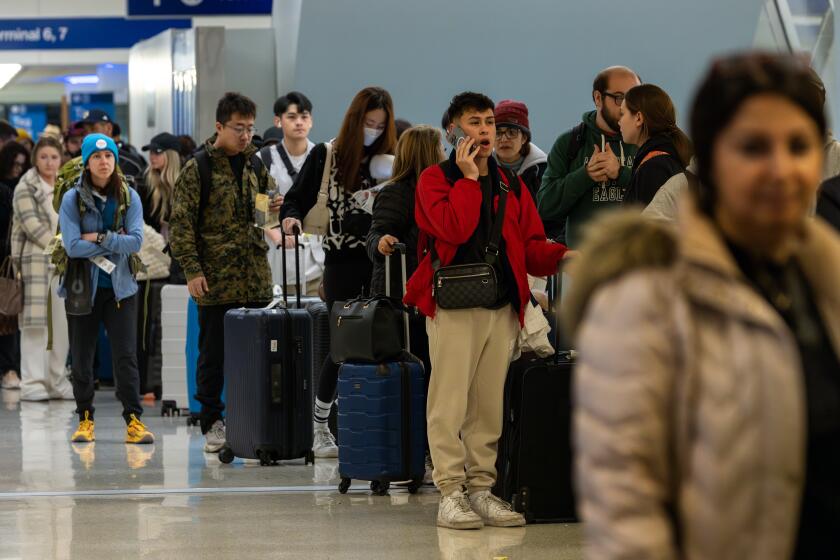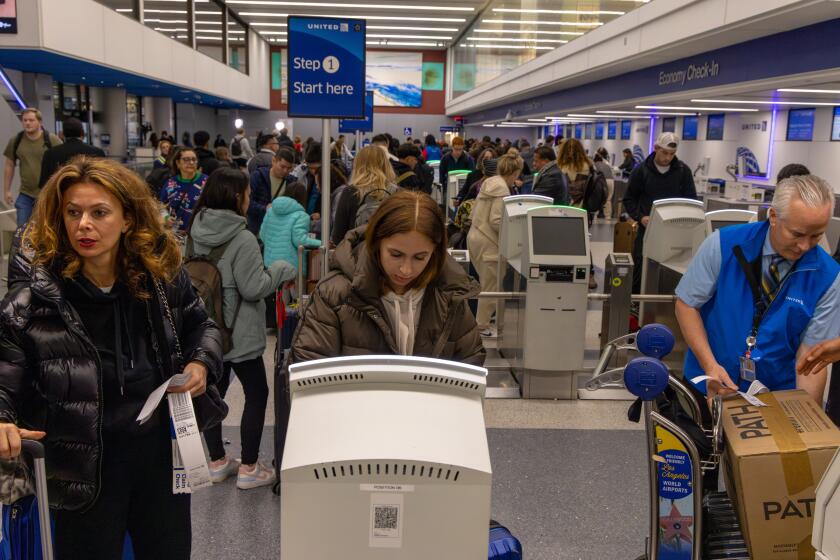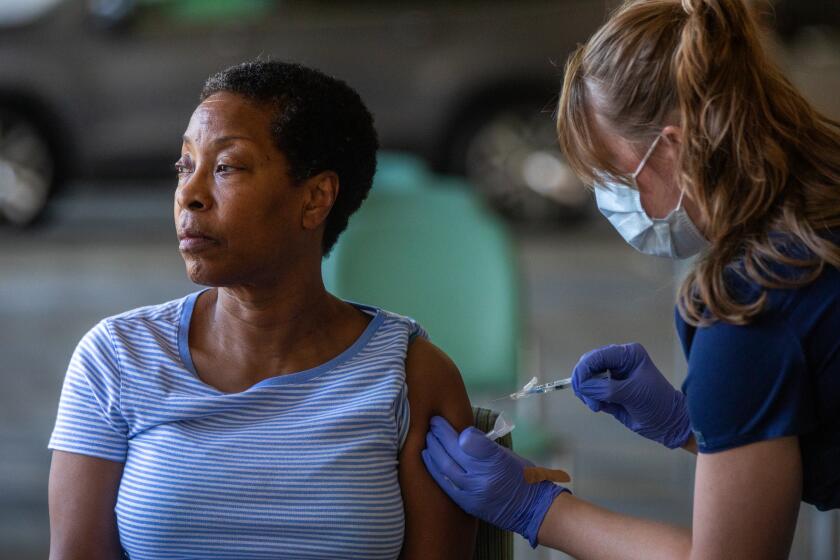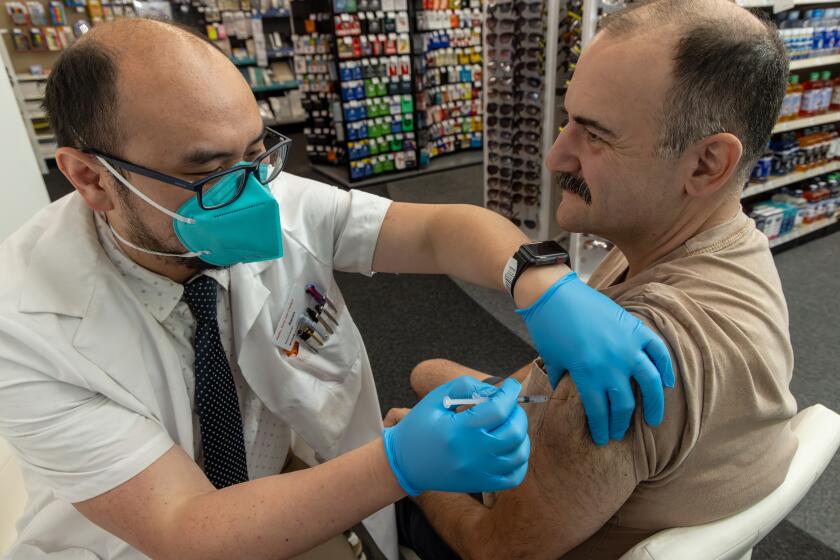Sick with COVID and the flu: Double infections hit California hard

California’s hospitals are getting busier with more COVID-19 and flu patients, some of whom are suffering from both viruses at the same time.
The simultaneous sickness is another wrinkle in an already hectic respiratory virus season. Although hospitals are not nearly as crowded as during the emergency phase of the pandemic, they are becoming increasingly so — with Los Angeles County recently entering the “medium” COVID-19 hospitalization category outlined by the U.S. Centers for Disease Control and Prevention for the first time this winter.
“Some of these patients are testing positive for more than one virus — influenza definitely likes to travel with COVID. [And] we’re seeing an outbreak of RSV,” said Dr. Daisy Dodd, an infectious disease specialist with Kaiser Permanente Southern California.
The viral cocktail could also include coronavirus or flu with RSV, or respiratory syncytial virus, simultaneously. Sometimes a common cold virus, like rhinovirus, is in the mix.
COVID-19, flu and respiratory syncytial virus (RSV) cases are all on the rise or at a high level in California and elsewhere.
And it’s not just the very young and the very old who are getting hit with a double whammy of disease — younger and middle-aged adults have also been afflicted. Dodd said she’s seen some patients reporting fevers lasting more than a week.
“Now it seems like everyone has this hacking cough that doesn’t want to go away,” she said. “It’s making them fairly sick and ... it’s not very gentle.”
For many of the patients who need medical attention, “they’re miserable. No doubt about it.”
It’s hard to say why doctors are seeing a number of viral co-infections this winter, experts say.
“Is it that one lowers the immunity and allows them to catch the other one easily? Don’t know the answer,” Dodd said. “But we’re seeing a lot of ‘double whammies’ going around.”
Coronavirus transmission is once again spiking in California entering the winter holiday season — and the new JN.1 subvariant may be partly to blame.
L.A. County’s entry into the “medium” COVID-19 hospitalization category has prompted local public health officials to order hospitals, nursing homes and any other inpatient facility to require healthcare employees mask up while in patient-care areas. Visitors to those facilities are also required to mask up in the same areas.
When a county enters the “medium” COVID-19 hospitalization level, those at high risk of getting very sick should wear a high-quality mask — such as a KF94, KN95, or N95 mask — when indoors in public, the CDC says.
The agency also says that those who live with, or have social contact with, someone at high risk should consider getting a rapid COVID test before meeting with them, and consider wearing a mask when meeting with them indoors.
A negative rapid COVID test result helps reduce, though does not entirely eliminate, the risk of passing along a coronavirus infection. There is a chance that a single rapid test may not detect an infection in its initial stages.
Multiple tests over a time period, such as over two or three days, can be helpful, “especially when the people using the tests don’t have COVID-19 symptoms,” according to the U.S. Food and Drug Administration.
California’s respiratory virus season is ramping up, prompting officials to renew their calls for residents to get vaccinated in hopes of reducing pressure on hospitals.
More infected people are being admitted into California’s hospitals. For the week that ended Dec. 23, 3,279 coronavirus-positive patients were newly admitted statewide, up 14% from the prior week and the highest weekly tally in 10 months.
New hospitalizations remain considerably lower than last winter’s peak, however. And a number of hospitals are not seeing signs of a COVID-19 surge in their intensive care units.
“Our ICUs are busy, but they’re not overwhelmed with COVID,” said Dr. Tevan Ovsepyan, medical director of the hospitalist program at Providence Holy Cross Medical Center in Mission Hills.
Still, the sickness season continues apace. California’s level of flu-like activity — which includes nonflu illnesses such as COVID-19 — recently rose to “very high,” one of the worst levels as defined by the CDC, for the first time this winter.
Ovsepyan said that at his hospital, there was an uptick in coronavirus-positive patients about a week and a half ago that has tapered off as of Friday. But, he said, “I don’t know what the future will hold, because ... we have New Year’s ... and people are getting together. So I’m sure we’ll probably see a little uptick.”
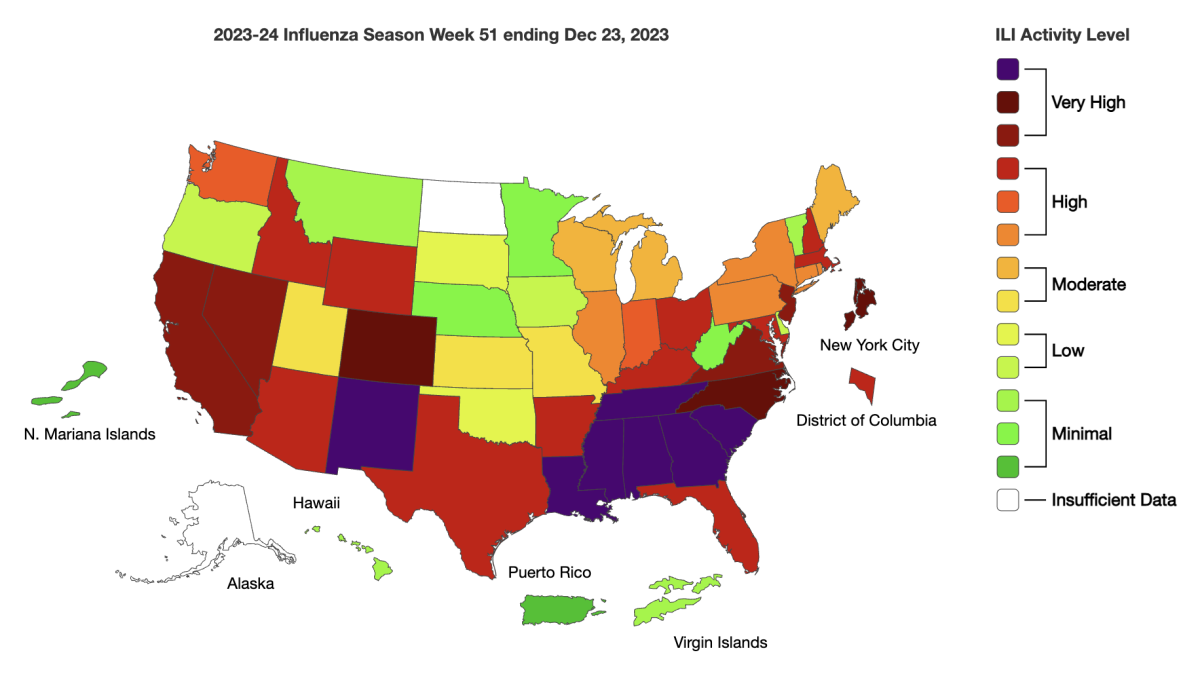
Other areas in California that are in the CDC’s “medium” COVID-19 hospitalization category include the four-county area around the state capital — Sacramento, Placer, Yolo and El Dorado counties — and several counties in the rural north: Butte, Tehama and Glenn.
The rate at which lab specimens are coming back positive for the coronavirus and flu is continuing to rise in L.A. County. For the week that ended Dec. 23, the most recent available, 23% of specimens tested at surveillance labs came back positive for flu, a jump from the prior rate of 18%. As for COVID-19, 12% of specimens are coming back positive for the coronavirus, an increase from the prior week’s 11%.
RSV, which can cause severe illness and death, especially among babies and older people, has plateaued at a high rate countywide, with 10% of specimens coming back positive over the most recent week. The positive test rate has stayed within 10% and 15% in recent weeks, a relatively high rate compared with the prior six years, but still below last year’s terrible RSV season, when the positive test rate exceeded 20%.
For the week that ended Dec. 4, L.A. County averaged five COVID-19 deaths a day, up from an average of two in mid-November, though still below last year’s numbers.
COVID-19 and flu are rising across California, sparking new warnings from health officials to take precautions as the wider winter holiday season looms.
In terms of severe illness and deaths, hospitals are in a better place than the terrible first winter of the pandemic and the initial Omicron wave the year after.
“Omicron was just horrible. It was a terrible time, because we were just overwhelmed with COVID-positive then, and people were sick,” said Ovsepyan, who is also chair of the hospital medicine department at Facey Medical Group, which has outpatient clinics in the San Fernando, Santa Clarita and Simi valleys.
Ovsepyan urged people to be responsible and stay home if sick.
And if you must leave the house and go anywhere there’s a crowd and have symptoms such as sniffles, “wear a mask,” Ovsepyan said.
“With time, people have had this COVID fatigue, and the fatigue of masks. That’s all reasonable,” Ovsepyan said. “But it’s still a virus. It still causes illness. It’ll be harmful for our frail patients, our elderly or people with co-morbid diagnosis ... those are the people who end up getting hospitalized.”
Only 5% of Californians have received the updated COVID-19 vaccine since it became more widely available earlier this month, and health officials say that’s not good enough.
People might initially shrug off a little sniffle or a tiny sore throat. But that can be the beginning of a full-fledged viral illness, and it would be “fabulous” if those who feel that start wearing a mask as soon as possible to protect others around them, Dodd said.
“Probably 95%, if not more, of respiratory infections, you feel it in your throat to begin with,” she said.
It’s likely a combination of factors that has led COVID-19 to be less deadly than it used to be, including protection provided by vaccinations and lingering immunity from infection, as well as the development of anti-COVID drugs that can be taken after infection.
But health officials worry about the lackluster utilization of those drugs, as well as lagging uptake of the latest COVID vaccines. The CDC urges virtually everyone age 6 months and older to get a fresh COVID-19 vaccination this winter, as well as the seasonal flu shot.
The updated COVID-19 vaccine is now available at all eight of L.A. County’s public health centers as well as clinics near Watts and East L.A.
RSV immunizations are also available for babies, those who are pregnant and people age 60 or older.
Officials urge more widespread use of antiviral drugs such as Paxlovid that can reduce symptom severity and the risk of hospitalization and death. They’re best taken early on, but many people aren’t doing so, or their healthcare providers aren’t prescribing them.
“There is an ample supply of COVID-19 therapeutic agents, but they have been underused,” the California Department of Public Health said in a health advisory. “Lack of familiarity with new medications ... and the misperception of drug scarcity have contributed to low treatment rates, including reports of eligible patients ultimately being denied treatment.”
California still offers a free telehealth service through Sesame Care, where sick people can talk to a healthcare provider by phone or online and get a prescription, if eligible. (A copay might be needed to pick up the prescription.) That service is available to Californians age 12 and up, regardless of insurance status, until February, by calling (833) 686-5051 or visiting sesamecare.com/covidca.
L.A. County residents can do the same by contacting the county’s Public Health Call Center at (833) 540-0473, which is open seven days a week from 8 a.m. to 8 p.m. The county says free and low-cost treatment is available for eligible patients, including those who are uninsured or on Medi-Cal.
A program funded by the National Institutes of Health, featured at test2treat.org, gives adults who test positive for COVID-19 or flu free access to telehealth care and treatment. That program is expected to run through the early summer. Adults who aren’t positive can still enroll to get free tests shipped to them if they are uninsured or underinsured; on Medicare or Medi-Cal; or in the healthcare system of the Department of Veterans Affairs or the Indian Health Service.
The U.S. government is also allowing residents to order free at-home COVID tests through COVIDtests.org. People are able to order four free at-home tests per household. And if they didn’t already place an order between Sept. 25 and Nov. 19, they’re eligible for two separate orders of four tests.
More to Read
Sign up for Essential California
The most important California stories and recommendations in your inbox every morning.
You may occasionally receive promotional content from the Los Angeles Times.
